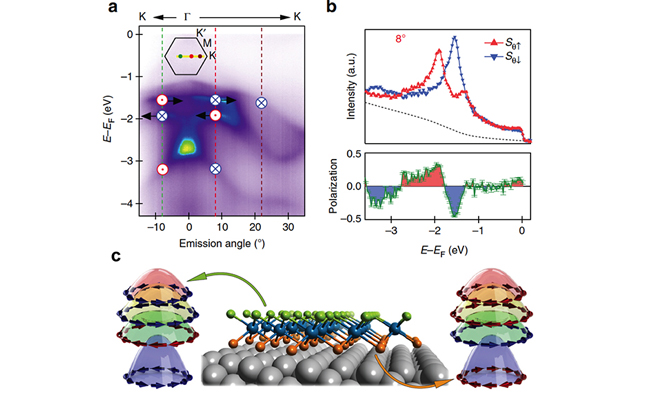Shuyun Zhou’s group reported helical spin texture induced by local Rashba effect in monolayer semiconducting PtSe2 film
Realizing controllable spin polarizations in semiconducting thin films is an important topic for spintronics research. On Jan. 31, 2017, Professor Shuyun Zhou’s group at the Department of Physics, Tsinghua University, reported the observation of a helical spin texture induced by a new mechanism in a monolayer semidoncuting PtSe2 film in a research article entitled “Direct observation of spin-layer locking by local Rashba effect in monolayer semiconducting PtSe2 film” in Nature Communications. The results not only enrich the understanding of the spin polarization physics but also may find appications in electrially tunable spintronics.
It has been conventionally believed that spin polarziation in nonmagnetic materials can be generated only by breaking the inversion symmetry of the crystal – the Rashba effect. This has limited the search for spintronics materials to noncentrosymmetric materials. Recent theoretical progess has, however, suggested that spin polarization can also be induced even in centrosymmetric materials by a new mechanism involving local dipole moment. This new mechanism is called local Rashba effect. More importantly, it has been expected that the spin polarization induced by this new mechanism could be easily controlled by an external electric field, thus making it potentially useful for electrically tunable spintronics devices. Experimental realization of the spin polarization by local Rashba effect in a semiconducting thin film is a critical step.
Shuyun Zhou group has performed angle-resolved photoemission spectroscopy (ARPES) and Spin-resolved ARPES (Spin-ARPES) measurements on monolayer PtSe2 film to reveal the electronic band structure and three-dimensional vectorial direction of electron spins with energy- and momentum-resolved information. Although the measured band structure is in good agreement with the calculated bands which are spin-degenerate, Spin-ARPES measurements reveal an interesting helical spin texture with a large degree of spin polarization (see Fig. 1a,b). Such experimental results cannot be explained by conventional Rashba effect, and can be explained only by invoking the local Rashba effect. First principles calculations confirm such a proposition and further show that spins with opposite helicities are indeed locked to the top and bottom Se sublayers respectively, forming spin-layer locking (Fig. 1c). This is also supported by an effective analytical model, thus confirming this work to be the first observation of local Rashba effect in centrosymmetric semiconducting thin films.

Prof. Shuyun Zhou (Physics Department, Tsinghua University) is the corresponding author of this work, and Wei Yao (Ph.D. student from Zhou group) is the first author. The collaborators include Prof. Wenhui Duan’s group (Physics Department, Tsinghua University), Prof. Chaoxing Liu (Physics Department, the Pennsylvania State University) and Prof. Hongjun Gao/Yeliang Wang’s group (Institute of Physics, Chinese Academy of Sciences). This research was funded by the National Natural Science Foundation of China, the Ministry of Science and Technology of China and the Tsinghua University Initiative Scientific Research Program.

